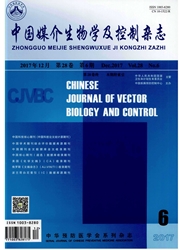

 中文摘要:
中文摘要:
目的了解云南省玉龙鼠疫疫源地媒介蚤类的群落结构、物种多样性特征及与鼠疫流行的关系。方法根据玉龙鼠疫疫源地的地理和植被分布特征,将该疫源地划分为4个不同梯度垂直带和两种生境(林地和耕地),于2015年3-12月,每季度利用夹夜法捕获小兽,并采集其体表寄生蚤,运用群落生态学指标对媒介蚤沿环境梯度的空间分布格局进行分析。结果共捕获小兽4目6科12属22种1 575只,检获体表寄生蚤3科8属12种1 031匹。其中,蚤类优势种为特新蚤指名亚种、方叶栉眼蚤和棕形额蚤指名亚种,占检获蚤类总数的86.13%。在Ⅳ垂直带蚤类物种丰富度和捕获数较高,为10种639匹,超过Ⅰ~Ⅲ垂直带捕获蚤总数。疫源地蚤类物种丰富度和数量的分布呈随海拔增加逐步增加的趋势,而多样性指数总体呈现随海拔增加先升高后降低的分布格局。结论玉龙鼠疫疫源地第Ⅳ垂直带表现为蚤类物种多样性和均匀度指数较低、优势度较高、总蚤指数最高和疫点分布较为集中等特征,表明该地为疫源地的核心区,应作为鼠疫监测和防治工作的重点区域。
 英文摘要:
英文摘要:
Objective To understand the community structures and species diversity of fleas, and their relationship with plague prevalence in Yulong plague focus, Yunnan province. Methods According to geography and vegetation distribution, Yulong plague focus was divided into four different altitude gradients and two different habitats (forest and agricultural area). Small mammals and their ectoparasite fleas were surveyed by using snap-trap method every quarter from March to December in 2015. The spatial distribution pattern of ectoparasite fleas along environmental gradients was studied using ecological indexes. Results A total of 1 031 ectoparasite fleas belonging to 12 species of 8 genera in 3 families were collected from 1 575 small mammals which belonged to 22 species, 12 genera, 6 families and 4 orders. The predominant species of fleas were Neopsylla specialis specialis, Ctenophthalmus quadrates, and Frontopsylla spadix spadix, accounting for 86.13% of total fleas. The fleas captured in altitude gradients Ⅳ had the highest species richness(10)and number of individuals(639), which was larger than the total of individuals in other three altitude gradients. With the increase of altitude, the species richness and number of individuals increased, while diversity index of fleas showed the trend of a gradual increase followed by a decrease. Conclusion In altitude gradient Ⅳ, ectoparasite fleas had low species diversity and evenness, high dominance and the highest total flea index, and epidemic sites were centralized. Therefore, gradient Ⅳ is not only the core area of Yulong plague focus but also the key area of the plague surveillance and prevention.
 同期刊论文项目
同期刊论文项目
 同项目期刊论文
同项目期刊论文
 期刊信息
期刊信息
